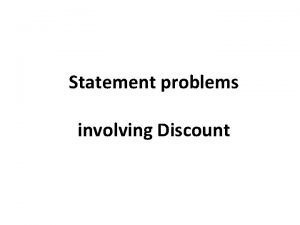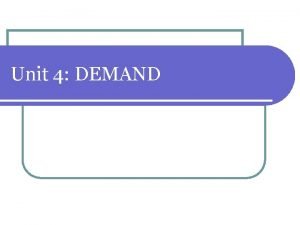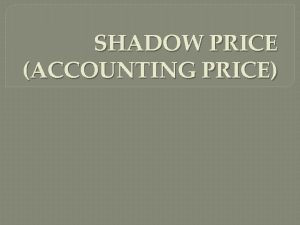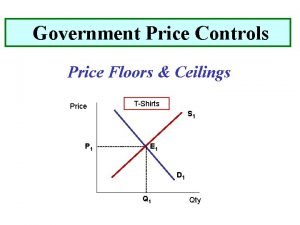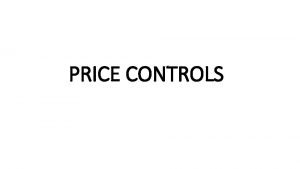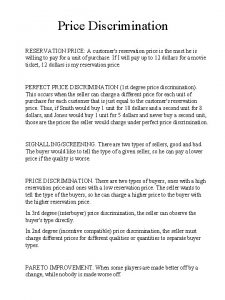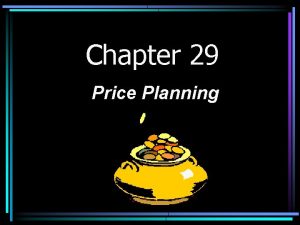How to Price Your Art Getting a work














- Slides: 14

How to Price Your Art Getting a work to the stage where you are satisfied with it is hard, but putting a price to it can be harder. Set the price too low and you may make your art look worthless, as well as lose money, rather than make money. Set the price too high and you risk never selling anything. How you decide to approach it depends somewhat on your personality, experience, and the stage your art career is at.

Tips for Pricing Your Art 1. Start Lower: It is easier to start low and then raise your prices than to lower your prices later. Plan ahead. Don’t price things at the last minute. This can lead to outrageously high or low prices depending on your mood, the economic situation or desire for attention. 2. Don’t Undersell Your Work or Yourself: Selling your work too cheaply means you’re not getting paid what the work is worth. Low prices set you up for all kinds of problems later including resentment from other artists who see you as “the cheap one”. Buyers seeing your work is cheap will question your credentials as an artist and diminish the quality of the work itself. 3. Never Under Sell Your Gallery: You have one price for your art – whether a gallery sells it or you sell it from home. Any gallery that gets wind that you sold at a lower price will drop you. Galleries do talk to one another. If you are not represented you have more pricing freedom. But beware of pricing your work too low. The Capitalist Approach: Make the Price Market Related: Do your homework by visiting galleries and studios in your area and target market(s) to see what similar type of art is selling for. Price yours to compete. If you are selling directly only (not through a gallery), offer “Special deals” to make people feel like they are getting a bargain. (If you are also selling through a gallery, never undercut their prices as you will undermine your business arrangement with them. 4. If you work fast and are prolific, your prices may be lower : than an artist whose work takes months to complete.

5. If you can’t keep work in stock – if you sell work as fast as you make it then it is time to raise your prices. 6. Large works are generally more expensive than smaller works. 7. Works made from higher-priced materials have a bigger price tag on them: Works made from canvas often command more than works on paper. But then there is framing. Likewise, bronze sculptures have higher prices than carved wood. . How much did the materials cost? How much time did you spend on it? Logically you don’t price your artwork less than the materials cost. You can price your work based on size – eg. An 8 x 10 cm is $100 or you spent 10 hours on it so you price it at $200. You can price it based on how long you spent on it – eg. You spent 5 hours so the price is $100, or you spent 10 hours so the price is $200. Or price the work on how much the materials cost, how much it is liked, how big it is and how much you need to sell it. Eg. - the materials for a painting cost $50 and it’s a 36 x 24 cm work, so you might price it at $300. Or it is a 16 x 20 cm work, and the materials cost $10, but you really like the painting, so maybe price it at $250. Price your work like a retailer, at twice the cost of materials. However, when starting out, you may have to sell at a cost basis to attract buyers if the materials or time involved result in an exorbitant price. The Simple Approach: Price Determined by Standard Sizes. All works that are the same size all have the same price tag, regardless of the subject, how long it took you to finish it, or how much you happen to like it. Your price list set out by size, with an additional set premium for commissioned works over finished works. 8. Artists who sell in smaller communities have also found it difficult to ask for prices similar to artists in larger cities. If you sell online (web-site) , you don’t just have a small-town audience any longer.

9. Conduct Market Research: Find comparables. Look for artists who do similar work using similar materials and who are at a similar point in their careers. Whenever you compare your prices to those of other artists, make sure you know that the work you are looking at is actually SELLING and not to what does not sell. Price your work based on documented accomplishments, sales history and exhibition history. Art sales are not immune to the ups and downs of the general economy. Artists should make necessary price adjustments to reflect market conditions. 10. Keep a Price List: When someone asks you who much something is, you want to be able to tell them quickly. You do not want to look like you are unsure or pulling a number out of the hat. A Mathematical Approach: Price Calculated by Area. You decide on a price for a square centimetre, then multiply the area of the work by this, then round it up to a sensible figure. Most people will use a calculator for this, but if you can do it with mental arithmetic then you never have to worry about a client who wanted to buy the work from you, and getting bored standing around while you hunt for a calculator.

12. Take into Account: are you just starting out as an artist or have you been around a while. If you are just starting out, you would price your artwork lower than you would if you had been a round for a while and made a name for yourself. Eg. When just starting out you may charge $60 or $80 for a 16 x 20 cm work, but 5 years later after you have had art shows etc. you could probably charge $300 for the same size work. Of course the QUALITY of the work should improve over this time as well. 13. The Accountants Approach: Recover Your Costs: Decide on a percentage profit you want to make over your costs. Then add up the costs of everything that went into making the work, add the percentage and you have your selling price. The costs calculation can be basic (materials + labour) or comprehensive (materials, labour, studio space, lighting etc. ). Every work has a different price, based on what went into creating it.

11. Radiate Confidence: This is powerful. If you are not confident in your prices spend time deciding on the prices, then have confidence in them – knowing that the prices are grounded in reality. 12. The Collector’s Approach: Increase Your Prices Every Year: Some people who buy art do it for investment reasons, and they want to believe the value of the work they have of yours is increasing. Read enough financial news to know what the current rate of inflation is, and be sure to increase your prices annually by at least this much.

13. The Creative Director Approach: Sell a Story, Not Just a Painting : Have a good tale to tell with every painting or (your chosen medium), hinting at it in the title, to create a sense of buying a little bit of the artist’s creativity, not just a product. Write or print it out on a little card to go with the art work to its new home. (Be sure to put your contact details on it. ) Hide your prices in the small print because it is so uncreative to talk about money. 14. An Instinctive Approach: Suck a Price Out of Your Thumb! Not recommended as a long-term approach, but to be considered if you are faced with a possible sale of a price that is in a new medium / ground for you or totally different to your “usual” style. Keep a track record of your time and expenses as most artists undervalue their work; often make less money on sales than they spent making work. (Materials, studio rent, utilities, phone, professional fees, fabrication costs, wages, transportation, postage, freight)

15. Prices: Above all defend your prices, you can defend the price of your work should your dealer or collector insist they are too high. Be realistic (include expenses for materials, studio rent, utilities, phone etc). As a starting point, use an hourly rate to calculate how much your art is worth (Australia - $20. 00 per hour). Letting a dealer, consultant or agent price your work is not always the best way to go. You should be part of the discussion and it should be a joint decision. Remember that gallery dealers calculate things like salaries, rent, marketing costs into valuing your work (as part of their commission). But then, gallery owners know the market and what their clients will pay. Some excuses you will hear and may be familiar with about pricing the work low is that you are an emerging artist, your résumé does not have the right venues, the work is small or derivative, or the dealer needs to spend more time and spend more to promote the work of emerging artists. Defend your work. Be negotiable, but don’t undervalue your work.


Artists with gallery experience and sales history should already have base prices set for their work(s). If you don’t have a track record of sales, your base price should approximate what artists in your area charge for similar works. Keep in mind that even though your art is unique, experienced art professionals, like dealers, advanced collectors, consultants and agents, make price comparisons from artist to artist all the time. Being able to evaluate your art from a detached standpoint, by comparing it to that of other artists in your area, is necessary in order for your price structure to make sense in the marketplace. Again! Keep work that holds special meaning for you or represents critical moments in your life off the market. You may want this work as part of your own private collection. There is a tendency to overprice such work. Do not price your work according to what region of the country or city your work is shown, or what gallery sells it. Consistent pricing is the cornerstone of a sound practice and eventually leads to successful sales. Selling the work from your home or studio – Always have a price list that states the full retail price. Always include a discount clause on the price sheet. This will get you out of a bind if a buyer raises it. Agree with your gallery or agent a discount policy, and who is to bear it?

16. Commission Splits: Galleries and art consultants take between 25% and 50% commission. Have a heart-to-heart talk with anyone who asks for a higher commission. Again often there will be a wide range of reasons for this, including that you are an emerging artist, your work(s) cost more to sell, gallery expenses, rent, rates, utilities, security, web-site up keep, maintenance. There also many non-profit organisations that take a commission for selling your work as well. There may be times when you may need to receive more than the price less than the agreed commission – if your work is very expensive to produce, or the fabrication is very costly (foundry work) , or you are using a specialised process. You will need to negotiate this up front before the commission split.

17. Prices to High: If people like your art enough to ask how much it is, but do not buy, it may be because your price structure is too high. Never arbitrarily cut prices or adjust them on the spur of the moment. Reduce your prices according to the consensus of knowledgeable people. Use your judgement. Never make your art so inexpensive that people will not take it. 18. Price Increases : The best time to increase prices is when you are experiencing a consistent degree of success and have established a proven track record of sales. Depending on what you make, and the quantity of your out put, you should be selling at least third to a half of everything that you produce within a 6 month period. If sales continue, and demand for your work remains high then a price increase of 7% - 10% per year is in order. Never raise prices based on whimsy, personal feelings or because you feel that prices have remained the same for so long. Your prices should remain stable until you have: increased sales, increased the number of exhibitions you have participated in, gained further gallery representation, or price rises generally have significantly increased.

19. Online Sales: Compare your prices to art available in your area. , as well as on the internet. Have a good selection of reasonably priced works available for purchase. Give the buyer the option of starting small, without having to risk too much money. Remember people are just beginning to get used to the idea of shopping on line for art. Hosting your work on the internet opens the doors to a different market. Many collections, collectors and patrons visit web-sites to see new artists who are outside of their area, but ho are selling work within their budget. 20. Discounts: You should not be required to split discounts with the gallery. It is a public relations expense for the gallery, dealer and the artist should not be paying for it. The gallery, dealer is generally awarding the buyer for previous patronage. Exceptions might be when a buyer purchases more than one work from you or has purchased work from you before. A gallery or dealer will issue the artist a purchase order, which states both commissions and the collector who brought your work. Always maintain records of who has purchased your work, including name, mailing address, email, phone number. Beware of dealers etc. who will not give you this information, you are entitled to a copy of the bill of sale and information relating to the buyer. 21. Market Fluctuations: No matter how long you have been making art, art prices fluctuate over time as a result of many factors. Set your initial price structure according to the initial value of your work, The more you are aware of market forces in general, and how people respond to your art, the better prepared you will be to maintain sensible selling prices and to maximize your sales.

The End
 Kilala bilang price support
Kilala bilang price support The secret of getting ahead is getting started
The secret of getting ahead is getting started Price your work
Price your work Management is the art of getting things done through others
Management is the art of getting things done through others The art of getting things done through people
The art of getting things done through people The art of getting along with others
The art of getting along with others 3.05 getting the most for your money
3.05 getting the most for your money Marked price-selling price=
Marked price-selling price= Hire purchase and installment payment system
Hire purchase and installment payment system 7 step sourcing methodology
7 step sourcing methodology Price discovery and price determination
Price discovery and price determination Answer this on your notebook
Answer this on your notebook Give us your hungry your tired your poor
Give us your hungry your tired your poor If you keep buying despite a price increase your demand is
If you keep buying despite a price increase your demand is What is contemporary framework
What is contemporary framework







